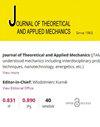水流玻璃窗中对流流动数学建模的若干问题
IF 1
4区 工程技术
Q4 MECHANICS
引用次数: 0
摘要
本文章由计算机程序翻译,如有差异,请以英文原文为准。
SOME PROBLEMS RELATED TO THE MATHEMATICAL MODELING OF CONVECTION FLOWS IN WATER FLOW GLAZING
A BSTRACT : This paper is a review of recent studies of the present authors related to the modeling of hydrodynamic and heat transfer processes in water-filled glazing chambers exposed to sunlight. Due to the absorption properties of water, solar visible and near-infrared irradiance induces a volumetric heat source with exponential decay. Three different scenarios of mixed natural and forced convection are discussed: two fully-developed flows in vertical flat and rectangular channels and a developing flow in a slender channel with a rectangular cross-section (similar to a Hele-Shaw cell). Three cases of temperature boundary conditions are studied for the lighted and the opposite walls, whereas in the case of the rectangular channel, linear declination of the side wall temperatures is applied. Analytical solutions for fully-developed flows in both flat and rectangular channels are reported and discussed. Some physical characteristics of the flows such as bulk liquid temperature and Nusselt number are calculated. The problem of developing flows in the slender rectangular channel is formulated in a “stream function-vorticity” version. The main conclusion is that the presented models predict quite well the average physical parameters of the mixed convection flows in the glazing chamber under solar radiation.
求助全文
通过发布文献求助,成功后即可免费获取论文全文。
去求助
来源期刊
CiteScore
1.40
自引率
14.30%
发文量
22
审稿时长
6 months
期刊介绍:
The scope of JTAM contains:
- solid mechanics
- fluid mechanics
- fluid structures interactions
- stability and vibrations systems
- robotic and control systems
- mechanics of materials
- dynamics of machines, vehicles and flying structures
- inteligent systems
- nanomechanics
- biomechanics
- computational mechanics

 求助内容:
求助内容: 应助结果提醒方式:
应助结果提醒方式:


